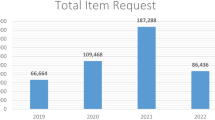This paper focuses on the technologies required to meet the global health diagnostics needs presented in the previous papers, highlighting how new diagnostic technologies might have the potential to change medical and public-health scenarios in the developing world.

Similar content being viewed by others
References
Bryce, J., Boschi-Pinto, C., Shibuya, K. & Black, R. E. WHO estimates of the causes of death in children. Lancet 365, 1147–1152 (2005).
Mulholland, K. Global burden of acute respiratory infections in children: implications for interventions. Pediatr. Pulmonol. 36, 469–474 (2003).
Breman, J. G., Alilio, M. S. & Mills, A. Conquering the intolerable burden of malaria: what's new, what's needed: a summary. Am. J. Trop. Med. Hyg. 71 (suppl. 2), 1–15 (2004).
Guinovart, C., Navia, M. M., Tanner, M. & Alonso, P. L. Malaria: burden of disease. Curr. Mol. Med. 6, 137–140 (2006).
World Health Organization. Making Every Mother and Child Count (WHO, Geneva, 2005).
World Health Organization. Paediatric HIV and Treatment of Children Living with HIV (WHO, Geneva, 2006).
Genc, M. & Ledger, W. J. Syphilis in pregnancy. Sex. Transm. Infect. 76, 73–79 (2000).
Mati, J. in Issues in Management of STDs in Family Planning Settings: Workshop Proceedings, 19–21 April 1995 (JHPIEGO, Baltimore, Maryland, 1996).
O'Ryan, M., Prado, V. & Pickering, L. K. A millennium update on pediatric diarrheal illness in the developing world. Semin. Pediatr. Infect. Dis. 16, 125–136 (2005).
World Health Organization. Water-Related Diseases: Diarrhoea [online] <http://www.who.int/water_sanitation_health/diseases/diarrhoea/en/> (2006).
World Health Organization. The World Health Report 2003: Shaping the Future (WHO, Geneva, 2003).
Adegbola, R. A. & Obaro, S. K. Diagnosis of childhood pneumonia in the tropics. Ann. Trop. Med. Parasitol. 94, 197–207 (2000).
Girosi, F. et al. Developing and interpreting models to improve diagnostics in developing countries. Nature S1, 3–8 (2006).
Berman, S. Epidemiology of acute respiratory infections in children of developing countries. Rev. Infect. Dis. 13 (suppl. 6), S454–S462 (1991).
O'Dempsey, T. J. et al. Importance of enteric bacteria as a cause of pneumonia, meningitis and septicemia among children in a rural community in The Gambia, West Africa. Pediatr. Infect. Dis. J. 13, 122–128 (1994).
Berkley, J. A. et al. Bacteremia among children admitted to a rural hospital in Kenya. N. Engl. J. Med. 352, 39–47 (2005).
Bahwere, P. et al. Community-acquired bacteremia among hospitalized children in rural central Africa. Int. J. Infect. Dis. 5, 180–188 (2001).
Patwari, A. K., Bisht, S., Srinivasan, A., Deb, M. & Chattopadhya, D. Aetiology of pneumonia in hospitalized children. J. Trop. Pediatr. 42, 15–20 (1996).
Gibot, S. et al. Soluble triggering receptor expressed on myeloid cells and the diagnosis of pneumonia. N. Engl. J. Med. 350, 451–458 (2004).
Baker, J. et al. Genetic diversity of Plasmodium falciparum histidine-rich protein 2 (PfHRP2) and its effect on the performance of PfHRP2-based rapid diagnostic tests. J. Infect. Dis. 192, 870–877 (2005).
Moody, A., Hunt-Cooke, A., Gabbett, E. & Chiodini, P. Performance of the OptiMAL malaria antigen capture dipstick for malaria diagnosis and treatment monitoring at the Hospital for Tropical Diseases, London. Br. J. Haematol. 109, 891–894 (2000).
Dyer, M. E., Tjitra, E., Currie, B. J. & Anstey, N. M. Failure of the 'pan-malarial' antibody of the ICT Malaria P.f/P.v immunochromatographic test to detect symptomatic Plasmodium malariae infection. Trans. R. Soc. Trop. Med. Hyg. 94, 518 (2000).
Phillips, M. et al. Volatile biomarkers of pulmonary tuberculosis in the breath. Tuberculosis, published online 22 Apr 2006 (doi:10.1016/j.tube.2006.03.004).
Lai, S. Y., Deffenderfer, O. F., Hanson, W., Phillips, M. P. & Thaler, E. R. Identification of upper respiratory bacterial pathogens with the electronic nose. Laryngoscope 112, 975–979 (2002).
Probert, C. S., Jones, P. R. & Ratcliffe, N. M. A novel method for rapidly diagnosing the causes of diarrhoea. Gut 53, 58–61 (2004).
National Center for Environmental Research. Ultrasensitive Biosensor for Detecting Biotoxins in Drinking Water. [online] <http://cfpub.epa.gov> (2004).
Yager, P. et al. Microfluidic diagnostic technologies for global public health. Nat. Insight Rev. 442, 412–418 (2006)
Chen, S., Selecman, G. & Lemieux, B. Expanding Rapid Nucleic Acid Testing [online] <http://www.devicelink.com/ivdt/archive/04/07/011.html> (2004).
World Health Organization. Guidelines on the use of Insecticide-Treated Mosquito Nets for the Prevention and Control of Malaria in Africa [online] <http://www.who.int/malaria/docs/pushba3.htm> (1997).
Acknowledgements
The authors thank B. Manian (Reametrix, San Carlos, California, USA,) S. Lwanga (Kampala, Uganda) and D. W. Kitimbo (District Director of Medical Services, Jinja District, Uganda).
Author information
Authors and Affiliations
Corresponding author
Additional information
This article has not been written or reviewed by the Nature editorial team and Nature takes no responsibility for the accuracy or otherwise of the information provided.
Rights and permissions
About this article
Cite this article
Urdea, M., Penny, L., Olmsted, S. et al. Requirements for high impact diagnostics in the developing world. Nature 444 (Suppl 1), 73–79 (2006). https://doi.org/10.1038/nature05448
Published:
Issue Date:
DOI: https://doi.org/10.1038/nature05448
- Springer Nature Limited
This article is cited by
-
A renal clearable fluorogenic probe for in vivo β-galactosidase activity detection during aging and senolysis
Nature Communications (2024)
-
Diagnostic performance of ultrasensitive rapid diagnostic test for the detection of Plasmodium falciparum infections in asymptomatic individuals in Kisangani, Northeast Democratic Republic of Congo
Malaria Journal (2023)
-
Paper-based sensors for bacteria detection
Nature Reviews Bioengineering (2023)
-
Development of non-electrically controlled SalivaDirect LAMP (NEC-SD-LAMP), a new nonelectrical infectious disease testing method
Scientific Reports (2023)
-
Adenosine triphosphate-activated prodrug system for on-demand bacterial inactivation and wound disinfection
Nature Communications (2022)





